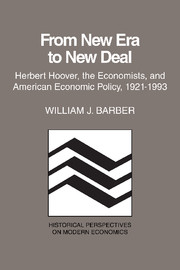Book contents
- Frontmatter
- Contents
- Preface
- Prologue: The vision of a new era in the 1920s
- 1 The ingredients of a model of a new economics
- 2 Challenges to the new economics of the 1920s
- 3 The new economics at center stage in 1929
- 4 Activating the stabilization model in late 1929 and 1930
- 5 Preliminary readings of the results of the stabilization strategy
- 6 The unraveling of the first official model in 1931
- 7 Shifting course in late 1931 and early 1932
- 8 Renewing the offensive in February and March 1932
- 9 The economists and their views on policy for 1932
- 10 Official model II as shaped in May 1932 and the aftermath
- Epilogue: Transition to the New Deal – continuities and discontinuities
- Notes
- Selected bibliography
- Index
7 - Shifting course in late 1931 and early 1932
Published online by Cambridge University Press: 19 October 2009
- Frontmatter
- Contents
- Preface
- Prologue: The vision of a new era in the 1920s
- 1 The ingredients of a model of a new economics
- 2 Challenges to the new economics of the 1920s
- 3 The new economics at center stage in 1929
- 4 Activating the stabilization model in late 1929 and 1930
- 5 Preliminary readings of the results of the stabilization strategy
- 6 The unraveling of the first official model in 1931
- 7 Shifting course in late 1931 and early 1932
- 8 Renewing the offensive in February and March 1932
- 9 The economists and their views on policy for 1932
- 10 Official model II as shaped in May 1932 and the aftermath
- Epilogue: Transition to the New Deal – continuities and discontinuities
- Notes
- Selected bibliography
- Index
Summary
Hoover had lost control of the agenda in mid-1931. Events, both at home and abroad, over which he could exercise no effective control had washed away the foundations of the original model of economic stabilization. But if the old model was no longer serviceable, what was to replace it? The pressures of day-to-day crisis fighting afforded little opportunity for reflection to develop a new body of doctrine. Though he had become the captive of events, Hoover was still determined to master them if he could. Certainly he remained persuaded that presidential guidance was crucial in the battle against depression. His long-standing doubts about the compatibility of the pursuit of private self-interest with the larger social good had been reinforced by his experience in the first two years at the White House. On its own, the private sector of the economy could not be relied upon to solve the economy's problems.
A new approach to the management of economic policy began to take shape in October 1931. Unlike the earlier doctrine of macroeconomic stabilization, it was not part of a preconceived grand design. Instead it emerged piecemeal, largely in response to immediate pressures of the moment. As its various components were put in place, it began to take on an internal coherence. Top priority on the new agenda was solidification of the banking system. Securing this base at home was the essential first step. Later, with American leadership, the international monetary system should be rebuilt.
- Type
- Chapter
- Information
- From New Era to New DealHerbert Hoover, the Economists, and American Economic Policy, 1921–1933, pp. 125 - 138Publisher: Cambridge University PressPrint publication year: 1985



